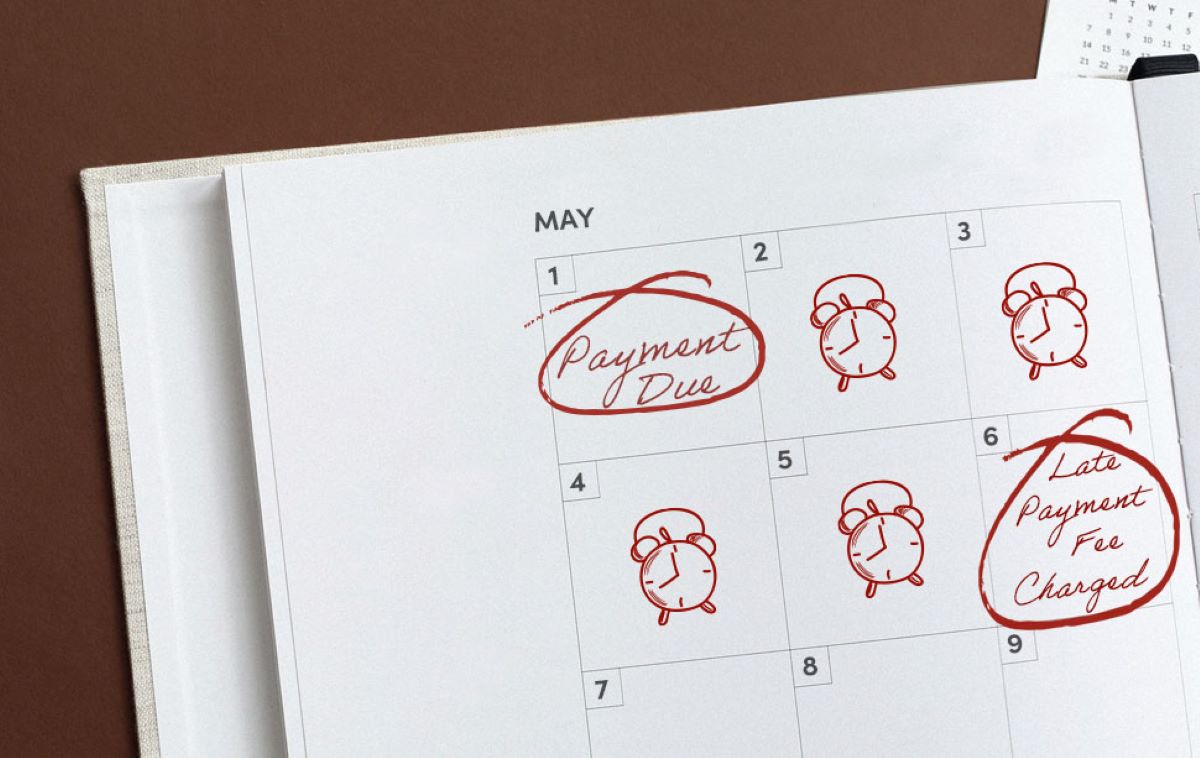

Finance
UF: How To Petition A Late Fee
Published: February 23, 2024
Learn how to petition a late fee and manage your finances effectively with our expert tips and advice on finance management. Take control of your financial situation today!
(Many of the links in this article redirect to a specific reviewed product. Your purchase of these products through affiliate links helps to generate commission for LiveWell, at no extra cost. Learn more)
Table of Contents
Understanding the Importance of Petitioning a Late Fee
Introduction
Late fees can be a source of frustration and financial strain for many individuals. Whether it's a late payment on a credit card, utility bill, or loan installment, these fees can quickly accumulate and exacerbate an already challenging financial situation. However, it's important to recognize that late fees are not always set in stone. In certain circumstances, it is possible to petition for the removal or reduction of these fees.
Petitioning a late fee involves presenting a formal request to the creditor or service provider, outlining the reasons for the late payment and providing any relevant supporting documentation. While success is not guaranteed, taking the initiative to address the late fee through a well-prepared petition can demonstrate responsibility and a commitment to resolving financial obligations.
In this guide, we will delve into the intricacies of petitioning a late fee, providing insights into understanding late fees, assessing the situation, preparing the petition, submitting the petition, and follow-up actions. By understanding these steps and the associated considerations, individuals can navigate the process of addressing late fees with confidence and determination. Let's embark on this journey to unravel the art of petitioning a late fee and reclaiming financial stability.
Understanding Late Fees
Late fees are charges imposed for failing to make a payment by the specified due date. These fees can apply to various financial obligations, including credit card payments, loan installments, rent, utility bills, and more. It’s essential to comprehend the implications of late fees, as they can significantly impact an individual’s financial well-being.
When a payment is not made on time, the creditor or service provider may levy a late fee as a penalty. This fee is typically outlined in the terms and conditions of the agreement or contract signed at the outset of the financial arrangement. Understanding the specific terms related to late payments is crucial, as it enables individuals to grasp the potential consequences and take proactive measures to address any late fees that may arise.
Late fees are not only a financial burden but can also have repercussions on credit scores and overall financial stability. For instance, consistently incurring late fees on credit card payments can lead to a negative impact on one’s credit history, potentially affecting future loan approvals and interest rates. Therefore, comprehending the gravity of late fees is pivotal in managing one’s financial responsibilities effectively.
Moreover, it’s important to recognize that late fees are not set in stone, and there may be opportunities to address them through formal petitioning. By gaining a thorough understanding of late fees, individuals can make informed decisions and take appropriate steps to mitigate their financial implications. In the subsequent sections, we will explore the process of assessing the situation, preparing a petition, and submitting it to the relevant entities in pursuit of fair and reasonable resolutions regarding late fees.
Assessing the Situation
Before embarking on the process of petitioning a late fee, it is crucial to assess the specific circumstances surrounding the late payment. This assessment involves a comprehensive review of the factors contributing to the late payment and an evaluation of one’s financial standing. By conducting a thorough assessment, individuals can gain clarity on the reasons for the late payment and determine the validity of their case for petitioning the associated late fee.
One of the initial steps in assessing the situation is to review the terms and conditions of the financial agreement or contract. Understanding the stipulations related to late payments, including the grace period, late fee amount, and any provisions for waivers or exceptions, is essential in determining the legitimacy of the late fee and the potential grounds for petitioning its removal or reduction.
Furthermore, individuals should evaluate the reasons for the late payment. Whether it was due to an unforeseen financial hardship, a misunderstanding of the payment deadline, or other extenuating circumstances, having a clear grasp of the underlying reasons can inform the formulation of a compelling petition. Gathering relevant documentation, such as proof of financial challenges, communication with the creditor or service provider, or any other supporting evidence, can bolster the case for petitioning the late fee.
Additionally, it is advisable to assess one’s overall financial situation to determine the feasibility of addressing the late fee. This involves reviewing income, expenses, and other financial obligations to ascertain the capacity to settle the late fee or negotiate a favorable resolution. Understanding the broader financial landscape can guide individuals in formulating realistic and actionable strategies for addressing the late fee through the petitioning process.
By conducting a comprehensive assessment of the situation, individuals can gain a nuanced understanding of the circumstances surrounding the late payment and the associated late fee. This insight serves as a foundation for preparing a well-informed and persuasive petition, increasing the likelihood of achieving a favorable outcome in petitioning for the removal or reduction of the late fee.
Preparing the Petition
Crafting a compelling petition to address a late fee requires meticulous preparation and attention to detail. The petition serves as a formal request to the creditor or service provider, outlining the circumstances of the late payment and presenting a persuasive case for the removal or reduction of the associated late fee. To prepare an effective petition, several key elements should be incorporated to strengthen the argument and increase the likelihood of a favorable response.
1. Clear and Concise Explanation: The petition should begin with a clear and concise explanation of the reasons for the late payment. Whether it was due to an unexpected financial hardship, a misunderstanding of the payment deadline, or other mitigating factors, providing a transparent account of the circumstances can humanize the situation and evoke empathy from the recipient of the petition.
2. Supporting Documentation: Including relevant supporting documentation, such as proof of financial challenges, correspondence with the creditor or service provider, or any other pertinent evidence, can substantiate the claims made in the petition. This documentation reinforces the credibility of the petitioner’s assertions and strengthens the case for addressing the late fee.
3. Acknowledgment of Responsibility: Expressing accountability for the late payment and articulating a commitment to fulfilling future financial obligations can convey a sense of responsibility and reliability. Demonstrating a proactive approach to rectifying the late payment can positively influence the recipient’s perception and disposition towards the petition.
4. Polite and Professional Tone: The petition should maintain a polite and professional tone throughout, emphasizing respect and courtesy in all communications. A respectful demeanor can enhance the persuasiveness of the petition and foster a constructive dialogue with the recipient, potentially leading to an amicable resolution regarding the late fee.
5. Proposal for Resolution: In some cases, proposing a specific resolution, such as a request for the late fee to be waived or reduced, can provide clarity and direction for the recipient. Presenting a well-reasoned proposal for addressing the late fee demonstrates proactive problem-solving and facilitates the recipient’s decision-making process.
By meticulously preparing the petition with these essential elements, individuals can present a compelling and persuasive case for addressing the late fee. The petition serves as a formal channel for articulating the circumstances, providing evidence, and appealing for a fair and reasonable resolution, laying the groundwork for potential success in petitioning for the removal or reduction of the late fee.
Submitting the Petition
Once the petition to address a late fee has been meticulously prepared, the next crucial step is its submission to the relevant entity, whether it is the creditor, service provider, or another designated recipient. The submission process requires careful consideration and adherence to specific protocols to ensure that the petition is effectively communicated and given due consideration.
1. Identifying the Appropriate Recipient: Before submitting the petition, it is essential to ascertain the correct recipient within the organization. This may involve contacting customer service, reviewing the terms and conditions of the financial agreement, or seeking guidance from a designated point of contact. Ensuring that the petition reaches the appropriate individual or department is fundamental to its successful consideration.
2. Method of Submission: Understanding the preferred method of submission is crucial in facilitating the efficient delivery of the petition. Whether it is through an online portal, email, postal mail, or another specified channel, adhering to the prescribed method ensures that the petition reaches the recipient in a manner consistent with their operational processes.
3. Timeliness and Follow-Up: Submitting the petition within a reasonable timeframe, taking into account any specified deadlines or grace periods, is imperative. Additionally, maintaining a record of the submission, such as a confirmation of delivery or receipt, enables individuals to follow up on the status of the petition if necessary. Timely and proactive follow-up demonstrates commitment and diligence in pursuing a resolution regarding the late fee.
4. Clarity and Comprehensiveness: Ensuring that the petition is presented with clarity and comprehensiveness enhances its effectiveness. The petition should succinctly convey the circumstances of the late payment, the rationale for petitioning the late fee, and any supporting evidence or documentation. A well-articulated and thorough submission increases the likelihood of the recipient fully understanding the petitioner’s position and making an informed decision regarding the late fee.
5. Professional Communication: Maintaining a professional and respectful tone in all communications related to the submission is paramount. Whether it is through written correspondence, email, or verbal interaction, upholding professionalism fosters a constructive dialogue and cultivates a positive rapport with the recipient, potentially influencing their disposition towards the petition.
By conscientiously navigating the process of submitting the petition, individuals can position themselves for a favorable consideration of their request to address the late fee. The submission represents a pivotal stage in the petitioning process, marking the formal presentation of the petitioner’s case and setting the stage for potential dialogue and resolution with the recipient.
Follow-Up Actions
Following the submission of a petition to address a late fee, engaging in strategic follow-up actions can significantly influence the outcome and demonstrate a proactive approach to resolving the matter. Effective follow-up entails persistence, professionalism, and a commitment to pursuing a fair and reasonable resolution regarding the late fee.
1. Timely Communication: Initiating timely communication with the recipient of the petition is essential in maintaining momentum and demonstrating earnestness in seeking a resolution. Whether it involves a courteous follow-up email, a phone call to inquire about the status of the petition, or any other form of contact, proactive communication underscores the petitioner’s commitment to addressing the late fee.
2. Clarification and Additional Information: If the recipient requests further clarification or additional information regarding the late payment or the circumstances outlined in the petition, promptly providing the requested details is crucial. Clear and comprehensive responses to any inquiries demonstrate transparency and a willingness to engage constructively in the resolution process.
3. Patience and Persistence: While maintaining persistence in follow-up actions, exercising patience is equally important. Recognizing that the resolution process may take time and necessitate thorough review and consideration by the recipient, individuals should balance persistence with patience, allowing the recipient sufficient time to assess the petition and make an informed decision.
4. Flexibility in Negotiation: In some instances, the recipient may propose alternative solutions or adjustments related to the late fee. Remaining open to constructive negotiation and demonstrating flexibility in considering reasonable proposals can facilitate a collaborative approach to resolving the matter. Constructive dialogue and flexibility can lead to mutually beneficial outcomes regarding the late fee.
5. Documenting Interactions: Keeping a record of all interactions, including communications, responses, and any agreements or commitments made by the recipient, is vital. Documentation provides a reference point for tracking the progress of the resolution process and serves as a safeguard in ensuring that all communications and agreements are upheld.
By diligently pursuing follow-up actions with professionalism and persistence, individuals can actively engage in the resolution process and maximize the potential for a favorable outcome regarding the late fee. Effective follow-up demonstrates commitment, fosters constructive dialogue, and positions individuals to achieve a fair and equitable resolution in addressing the late fee through the petitioning process.














